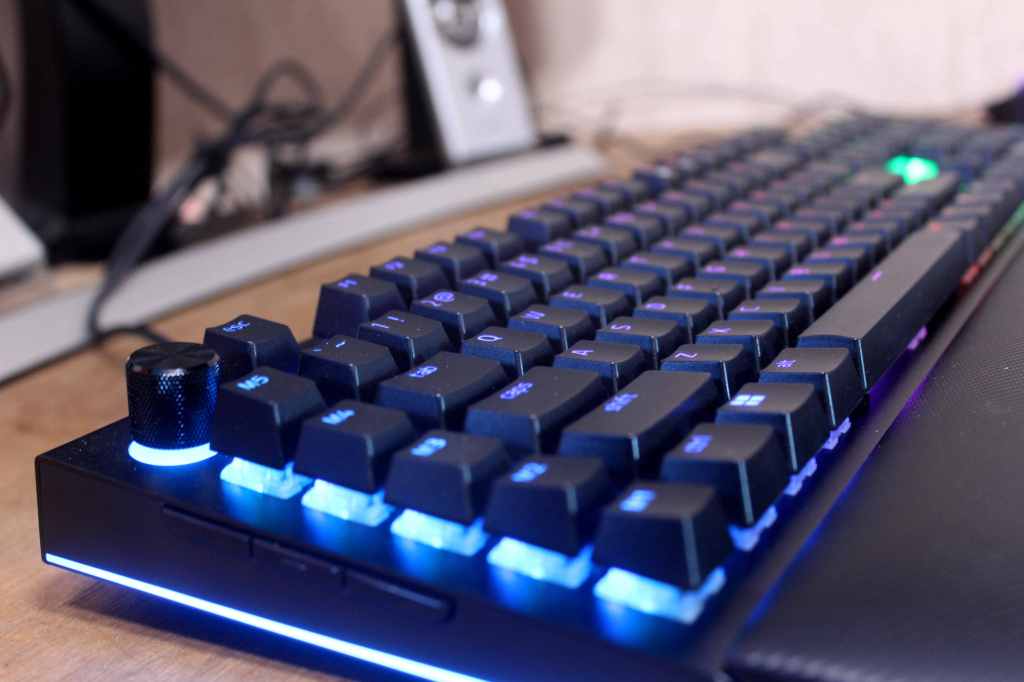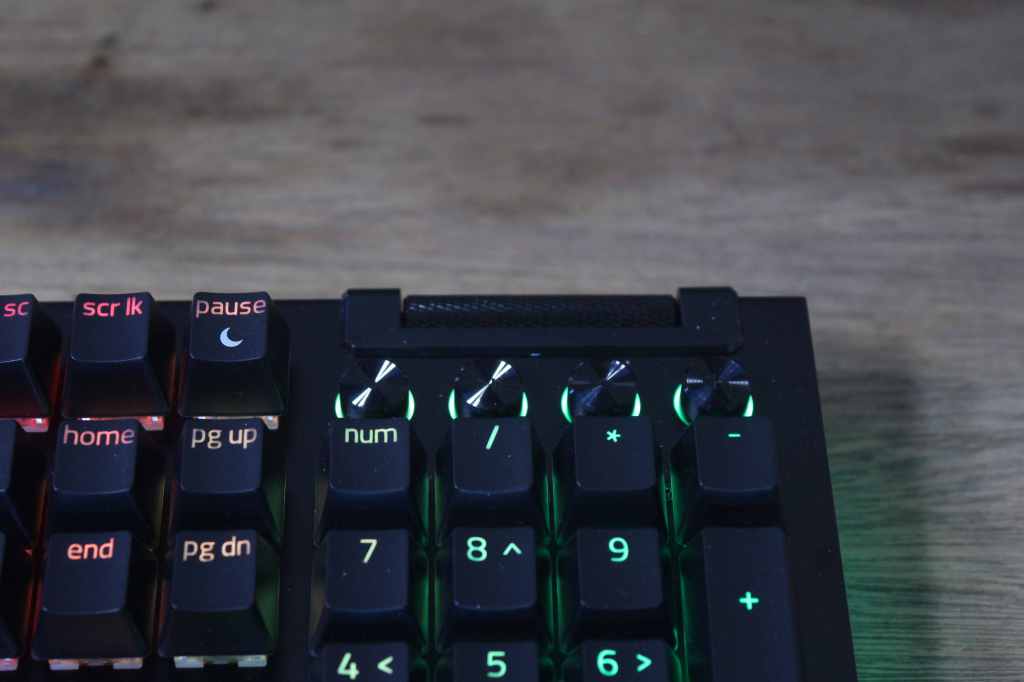
Razer’s approach to designing the BlackWidow V4 Pro was to throw everything at it, a fitting plan for anything with the word ‘Pro’ in its name. It’s a mechanical keyboard that dominates your desk thanks to it being slightly larger than a regular full-sized board and being adorned with enough lights to confuse a UFO into thinking it’s a friend. It’s peppered with macro keys, has great mechanical switches and comes with a super comfy wrist rest. But all the bells and whistles equal a hefty price of around £230, which makes my bank card quiver in fear and my heart skip a beat or ten.
Interestingly, Razer has ditched the wireless capabilities of the BlackWidow V3 completely, going back to good old USB cables to power the whole thing. Two come in the box, both USB-C to USB-A, but only one is needed to use the keyboard. The second one is simply to enable the passthrough function of the BlackWidow’s third USB port, handy for plugging in drives or charging devices. Having to use two slots on the computer is a bit of a bummer, but that’s the reality of passthrough ports – one to cable to power the keyboard itself, and the second to power the passthrough.
Dropping the BlackWidow onto my desk, alongside my Basilisk V3 mouse, my initial impressions were size. I’ve been using my trusty BlackWidow Lite, a small tenkeyless board that suited me perfectly since I don’t have a use for NUMpad. The difference in size is like Godzilla staring down at shocked Iguana, and I spent the first while with the BlackWidow getting used to having my mouse all the way over there when I was typing. It’s even bigger than a regular keyboard. For comparison, a typical keyboard will be approximately 43cm by 15cm, whereas the BlackWidow measures 46.6cm by 15.27, not counting the wrist rest. That’s only a few more centimetres yet it’s surprising just how much more chunky it makes the whole thing look and feel.

With such a high price tag it’s only right to expect good build quality, especially from a big name like Razer. The good news is that apart from one or two small niggles the BlackWidow V4 Pro is sturdy and feels premium. The chassis is made from an aluminium backplate to give it strength, bringing the weight to about 1.5 KG. There’s no flex when you’re typing or even when you push down on the keyboard, and the two different heights of feet on the rear don’t feel like they are going to snap off. That niggle I mentioned? Well, it’s that Razer went for ABS (Acrylonitrile Butadiene Styrene) keycaps rather than the more durable PBT (Polybutylene Terephthalate) found on a lot of other premium keyboards. Simply put, ABS plastic tends to wear away slowly, leaving your most used keys with a shiny, glossy look and might even result in the legends being worn away. PBT is much thicker and much more durable. But from what I can tell, Razer did opt for doubleshot keycaps, meaning there are two layers of bonded plastic on the top which is typically quite durable.
Razer is known for subscribing to the theory that more lights equal more performance. Their dedication to that mantra is immediately evident when the BlackWidow V4 Pro is plugged in, every key suddenly bursting with light. They’ve gone with an underglow design here, meaning the key caps aren’t flush with the frame so that the RGB lighting can flow out, giving the impression that the keys are floating on an ocean of colour. If you aren’t a fan of RGB lighting then it can all be turned off, but I happen to love me some pretty lights and I reckon it looks awesome. Every key is individually lit and the colour reproduction is lovely, even stuff like the notoriously hard yellow.
Via the Razer software, you can set pick from a decent selection of preset lighting options, like spiralling colours, gentle waves or just a static hue. But fiddling with it all yourself is far more fun, and the range of options that the software gives you is pretty damn impressive. No matter what garish concept you have in mind, you should be able to replicate it.
The BlackWidow V4 comes in two distinctive flavours of mechanical switch: green or orange. The orange switches are quieter and linear, the goal being a smooth and reasonably hushed experience. But I like noise, so naturally, I opted for Razer’s green switches which are clicky, loud and fast to activate. They need 50g of actuation force which is actually a little on the heavier side but are never tiring to use. They’re fast and responsive, with a 1.9mm activation point. Each press feels crisp and the keys bounce back like Rocky Balboa Razer says these are perfect for gamers but I found them to be just as enjoyable for typing due to their tactile, satisfying nature. Each stroke results in a tasty bump and very audible click that sounds a little plasticky, although that didn’t stop them from pleasing that little bit of my dumb brain that loves loud keyboards. Two layers of internal foam help deaden the noise generated by the case itself and do a decent job of it. The exceptions are the larger keys like the spacebar and enter which have a less pleasing thump to them.
For an idea of what the keyboard sounds like, check out the video below, courtesy of Rawr Audio.
Naturally, this does not lend itself well to a work environment or for anyone who has a family and likes to game at night. The loud keys are quite likely to result in your untimely death at the hands of a colleague, partner or even offspring. It could also be a problem during multiplayer games because without a good noise-isolating microphone the sound of you desperately hitting the crouch button will be travelling directly to your team’s ears.
As for the orange switches, they need a bit less pressure at just 45g and actuate at just 1.2mm. In theory, then, they should make quick typing easier, and the silicon sound dampeners will help keep them nice and quiet compared to the green switches which are quite capable of rousing the dead. However, I didn’t get to try the orange switches myself. The closest I got is my BlackWidow Lite which sports orange switches, but that was a few generations ago and I don’t know how much Razer has changed its design since then.
Typing can be hard work so it’s good that the BlackWidow v4 Pro comes with a rather luxurious padded wrist rest that magnetically clips onto the keyboard. It has a gently textured surface that feels great on your skin and it does an excellent job of supporting your wrists. Previous rests from Razer were basic metal frames with padding, so you could occasionally feel it through the material. This time Razer has folded the material around the frame, making it look nicer and feel nicer I also appreciate the subtle Razer logo on the rest. It’s surprisingly understated for a company like Razer which firmly believe an empty space without lights is a space wasted. Speaking of which, as soon as the wrist rest is attached, a strip of LED lighting is activated that runs around the edge, making the wrist support seem like it’s built into the chassis instead of an external component.

For testing, I tried to put the keyboard through its paces as much as I could. Typing wasn’t hard since I do a lot of that anyway. My last three reviews plus this one have all been done on the BlackWidow V4 Pro and it performed brilliantly. My speed and accuracy did take a small hit but that’s been due to changing over and my results have been going back to normal. Stuff like Company of Heroes 3 and Pharaoh: A New Era aren’t exactly keyboard-heavy games, so I fired up a bunch of other stuff like Doom: Eternal and Atomic Heart to see what it would do under pressure. The answer is extremely well, and some of that stems from the fact the keyboard can go all the way up to an 8,000Mhz polling rate. It’s overkill for the majority of people, myself firmly included, but the option to have the keyboard reporting to the computer that quickly is excellent and the most competitive folk out there might feel the difference. Personally, I didn’t go above 4,000 at the most and felt like everything was super snappy at that.
There’s a reason the V4 Pro is slightly oversized: Razer wanted to cram in a whole bunch of extra buttons and goodies sure to please anyone who uses shortcuts and macros to their fullest. Over on the left, there’s a column of five macro keys to fiddle around with and the Razer software makes creating macros pretty easy. Their location proved a tad tricky because I kept reaching out with my pink to hit the shift and ended up pressing a macro key instead, but I adjusted to that quickly and started playing around with them for various in-game uses like swapping weapons in Atomic Heart or quickly selecting a build tab in Company of Heroes 3. With a bit of practice, it was easy to flick my pinky finger over there. For more everyday stuff I assigned one to copy and another to paste.
Lurking above the macro keys is a fancy aluminium dial that has a nice subtle diamond texture. Razer calls this the Command Dial, a dramatic name for a cool-looking do-da. It has eight preset modes, of which a few are activated out of the box, and by clicking the dial you can swap between them. For example, the dial can control the brightness of the lights, swap between open programs, horizontal scrolling and vertical scrolling. By delving into Razer’s software you can create new custom modes that alter how the dial behaves when turned left or right. Personally, I didn’t find a whole lot of use for it and so I wound up setting it to volume control. I’m not entirely sold on how useful the Command Dial will be. But I do think it could find some niche use, like maybe someone who does a lot of video and audio editing will use it for scrubbing through their work.
There are three more buttons hidden away on the left of the keyboard that are, by default, programmed to take a screenshot, open up the Xbox app and bring up the task view. But like almost all the other keys on the BlackWidow they can be changed using the software to do whatever you’d like. Their positioning on the keyboard is a little dubious, though, because they sit exactly where your hand falls whenever you go to shift the BlackWidow V4 Pro around. Since I swap between gaming and long typing sessions constantly, I ended up hitting the buttons by accident a lot. I got used to it quickly, though. For gaming, they are pretty much useless as their location doesn’t make them easy to reach in a hurry. For productivity and working they could be quite useful, though.

Over on the right, there are four machined aluminium media buttons with just a hint of texture to them. These are media control keys that are set to pause or skip back and forth, though like everything else they can be changed. They look nice and sleek, but that comes at the cost of legibility. The legends on each button are small and coloured in a dark grey, so the light from my monitor was enough to completely obscure them. Until I could remember what each one did, I had to squint like a grandma trying to read the fine print.
Just up from those little media keys is a chunky volume roller that has a nicely balanced ratchet effect and the same subtle diamond texture as the Command Dial. I really like how it feels to use, and like everything else you can always reprogram it to do something else.
But speaking of programming stuff, we do need to talk about Razer’s software which is often cited as the weakest aspect of its products. These days I find it is pretty decent in most respects. Creating macros is a doddle, reprogramming everything is easy and fiddling with the lighting is reasonably intuitive. Really, the biggest issue is that sometimes the software is slow to start up, so the keyboard might suddenly change colour a few minutes after the computer boots.
The BlackWidow V4 Pro is undoubtedly an excellent keyboard packed with features and boasting great switches that speak to my love of loud keys. The question is whether it’s worth the colossal price tag of £230. That could almost buy you a Nintendo Switch or an Xbox Series S. The simple answer is that you should never spend that much on a keyboard. It’s absurd. It’s a practical tool and all those extra bells and whistles are nice to have but hardly life-changing for the vast majority of people. But that doesn’t stop me from loving it, and it doesn’t change the fact that we tech geeks do tend to spend a lot of money on stuff like this all the time.
So let’s put the price to one side, for the moment, because cost is a relative thing and what one person refuses to pay for fancy lights and mechanical switches, another person is happy to. There’s a lot to love here: Razer’s green switches feel excellent for typing and gaming, the padded wrist rest is ultra comfortable, the macro keys are excellent and the lighting is gorgeous. There are a few let-downs like the Command Dial not being all that useful and the fact that the keys use cheaper plastic than other premium boards out there, but overall the complaints are fairly small, and for the more productivity-minded folk the Command Dial could be useful.
For those willing to strain their bank account for the best possible typing and gaming keyboard, the Razer BlackWidow V4 Pro is an exceptional piece of kit with numerous useful features that make it great for fun and work. There are a few little issues, but none of the detract very much from the V4 Pro which may very well be Razer’s best ever keyboard.

Buy the BlackWidow V4 Pro On Amazon!
By clicking this button you’ll be taken directly to Amazon via my affiliate link where you can buy the game! This costs you absolutely nothing but earns http://www.wolfsgamingblog.com a small commission. The perfect way to help support the site!




